American actress Colleen Moore (1899-1988) was a star of the silent screen who appeared in about 100 films beginning in 1917. During the 1920s, she put her stamp on American social history, creating in dozens of films the image of the wide-eyed, insouciant flapper with her bobbed hair and short skirts.
![Colleen Moore]()
French postcard by Cinémagazine-Edition, Paris, no. 212. Photo: First National Pictures.
![Colleen Moore]()
German postcard by Ross Verlag, no. 3683/3, 1928-1929. Photo: First National Pictures.
![Colleen Moore]()
German postcard by Ross Verlag, no. 3469/2, 1928-1929. Photo: Defina / First National Pictures.
![Colleen Moore]()
German postcard by Ross Verlag, no. 3862/1, 1928-1929. Photo: Defina / First-National-Film.
![Colleen Moore and Antonio Moreno in Synthetic Sin (1929)]()
German postcard by Ross Verlag, no. 4943/1, 1929-1930. Photo: First National Pictures / Defina. Publicity still for Synthetic Sin (William A. Seiter, 1929) with Antonio Moreno.
![Colleen Moore]()
British Real Photograph postcard.
Colleen Moore was born Kathleen Morrison in Port Huron, Michigan in 1899 (the date which she insisted was correct in her autobiography 'Silent Star' was 1902). Her father was an irrigation engineer and his job was good enough to provide the family a middle-class environment.
She was educated in parochial schools and studied piano at the Detroit Conservatory. As a child she was fascinated with films and stars such as Marguerite Clark and Mary Pickford and kept a scrapbook of those actresses.
By 1917 she was on her way to becoming a star herself. Her uncle, Walter C. Howey, was the editor of the Chicago Tribune and had helped D.W. Griffith make his films The Birth of a Nation (1915) and Intolerance: Love's Struggle Throughout the Ages (1916) more presentable to the censors. Knowing of his niece's acting aspirations, Howey asked Griffith to help her get a start in the film industry.
No sooner had she arrived in Hollywood than she found herself playing in five films that year, The Savage (Rupert Julian, 1917) being her first. Her first starring role was as Annie in Little Orphant Annie (Colin Campbell, 1918).
Colleen was on her way. She also starred in a number of B-films and in Westerns opposite Tom Mix, like The Wilderness Trail (Edward LeSaint, 1919) and The Cyclone (Clifford Smith, 1920).
![Colleen Moore]()
French postcard by Editions Cinémagazine, no. 178. Photo: Melbourne Spurr.
![Colleen Moore]()
German postcard by Ross Verlag, no. 731/1, 1925-1926. Photo: Transocean-Film-Co., Berlin.
![Colleen Moore]()
German postcard by Ross Verlag, no. 731/2, 1925-1926. Photo: Transocean-Film-Co., Berlin.
![Colleen Moore]()
German postcard by Ross Verlag, no. 896/2, 1925-1926. Photo: First National Pictures, New York.
![Colleen Moore in The Desert Flower (1925)]()
Austrian postcard by Iris-Verlag, no. 565-1. Photo: First-National-Film. Publicity still for The Desert Flower (Irving Cummings, 1925).
![Colleen Moore in The Desert Flower (1925)]()
Austrian postcard by Iris-Verlag, no. 565-2. Photo: First-National-Film. Publicity still for The Desert Flower (Irving Cummings, 1925).
![Colleen Moore]()
German postcard by Ross Verlag, no. 1184/1, 1927-1928. Photo: First National Pictures.
The film which defined Colleen Moore as the inventor of the 'flapper' look was Flaming Youth (John Francis Dillon, 1923), in which she played Patricia Fentriss. Her Dutch bob in the film was soon copied by hairdressers across America and her air of an emancipated young woman inspired countless imitations.
In 1923, she married the first of her four husbands, Frank McCormick, production head of First National Pictures, later part of Warner Brothers. There followed such films as The Perfect Flapper (John Francis Dillon, 1924), The Desert Flower (Irving Cummings, 1925), Ella Cinders (Alfred E. Green, 1926) and Her Wild Oat (Marshall Neilan, 1927).
By 1927 she was the top box-office draw in the US, making $12,500 a week. Her second husband was a New York broker, Albert F. Scott. Moore put her money into the stock market, making very shrewd investments.
She took a hiatus from acting between 1929 and 1933, just as sound film was introduced. Her four sound pictures released in 1933 and 1934 were not financial successes. Moore then retired permanently from screen acting. Her final film role was as Hester Prynne in The Scarlet Letter (Robert G. Vignola, 1934).
In 1937 she married her third husband, Homer Hargrave, again a stockbroker, and ended her film career. After she retired she wrote two books on investing and she travelled widely, frequently to China.
At 83, she married her fourth husband, builder Paul Maginot. In 1988, Colleen Moore died of an undisclosed ailment in Paso Robles, California. She was 88. At the time of her death she was writing a novel, a Hollywood murder mystery centred around a Mae West type.
Tragically, approximately half of Moore's films are now considered lost. Of her most celebrated film, Flaming Youth (1923), only one reel survives.
![Colleen Moore]()
Austrian postcard by Iris-Verlag, no. 5855. Photo: First National-Film.
![Colleen Moore]()
French postcard by Editions Cinémagazine, no. 311.
![Colleen Moore as Madame Butterfly.]()
French postcard by Cinémagazine-Edition, no. 572. Photo: Roman Freulich /First National. The photo was specially posed for Motion Picture magazine in 1928.
![Colleen Moore]()
German postcard by Ross Verlag, no. 1184/21, 1927-1928. Photo: First National Pictures.
![Colleen Moore]()
German postcard by Ross Verlag, no. 1871/1, 1927-1928. Photo: First National Pictures / Fanamet.
![Colleen Moore]()
German postcard by Ross Verlag, no. 3298/1, 1928-1929. Photo: E.O. Hoppé.
![Gary Cooper and Colleen Moore in Lilac Time (1928)]()
German postcard by Ross Verlag, no. 4365/1, 1929-1930. Photo: Defina / First National. Publicity still for Lilac Time (George Fitzmaurice, 1928) with Gary Cooper.
![Colleen Moore in Oh Kay! (1928)]()
German postcard by Ross Verlag, no. 4366/2, 1929-1930. Photo: Defina / First-National-Film. Publicity still for Oh Kay! (Mervyn LeRoy, 1928).
![Colleen Moore]()
German postcard by Ross Verlag, no. 4560/1, 1929-1930. Photo: Defina / First National.
![Colleen Moore]()
German postcard by Ross Verlag, no. 4560/2, 1929-1930. Photo: Defina / First National Pictures.
![Colleen Moore]()
German postcard by Ross Verlag, no. 5188/1, 1930-1931. Photo: First National / Defina.
![Colleen Moore and Neil Hamilton in Why Be Good (1929)]()
British postcard, no. 9. Photo: First National Pictures. Colleen Moore and Neil Hamilton in Why Be Good? (William A. Seiter, 1929).
Sources: Glenn Fowler (The New York Times), Denny Jackson (IMDb), Ed Stephan (IMDb), Wikipedia and IMDb.
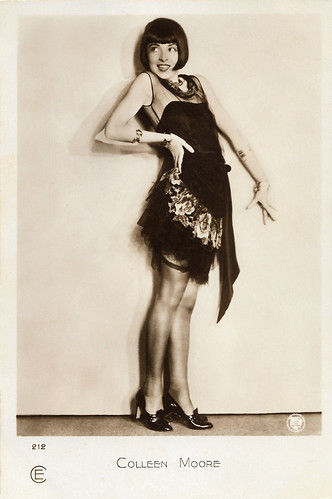
French postcard by Cinémagazine-Edition, Paris, no. 212. Photo: First National Pictures.

German postcard by Ross Verlag, no. 3683/3, 1928-1929. Photo: First National Pictures.
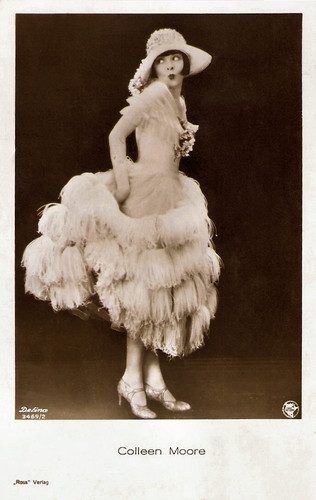
German postcard by Ross Verlag, no. 3469/2, 1928-1929. Photo: Defina / First National Pictures.
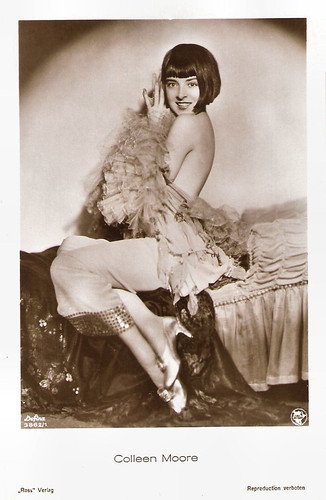
German postcard by Ross Verlag, no. 3862/1, 1928-1929. Photo: Defina / First-National-Film.
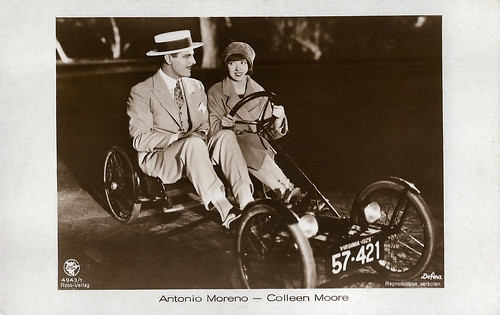
German postcard by Ross Verlag, no. 4943/1, 1929-1930. Photo: First National Pictures / Defina. Publicity still for Synthetic Sin (William A. Seiter, 1929) with Antonio Moreno.
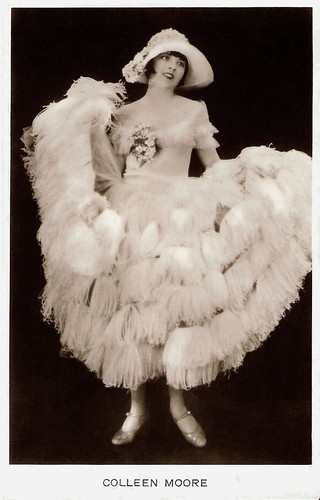
British Real Photograph postcard.
Colleen was on her way
Colleen Moore was born Kathleen Morrison in Port Huron, Michigan in 1899 (the date which she insisted was correct in her autobiography 'Silent Star' was 1902). Her father was an irrigation engineer and his job was good enough to provide the family a middle-class environment.
She was educated in parochial schools and studied piano at the Detroit Conservatory. As a child she was fascinated with films and stars such as Marguerite Clark and Mary Pickford and kept a scrapbook of those actresses.
By 1917 she was on her way to becoming a star herself. Her uncle, Walter C. Howey, was the editor of the Chicago Tribune and had helped D.W. Griffith make his films The Birth of a Nation (1915) and Intolerance: Love's Struggle Throughout the Ages (1916) more presentable to the censors. Knowing of his niece's acting aspirations, Howey asked Griffith to help her get a start in the film industry.
No sooner had she arrived in Hollywood than she found herself playing in five films that year, The Savage (Rupert Julian, 1917) being her first. Her first starring role was as Annie in Little Orphant Annie (Colin Campbell, 1918).
Colleen was on her way. She also starred in a number of B-films and in Westerns opposite Tom Mix, like The Wilderness Trail (Edward LeSaint, 1919) and The Cyclone (Clifford Smith, 1920).
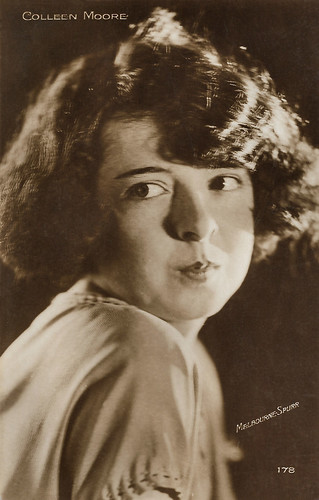
French postcard by Editions Cinémagazine, no. 178. Photo: Melbourne Spurr.
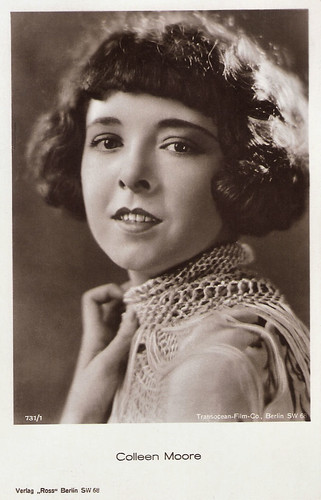
German postcard by Ross Verlag, no. 731/1, 1925-1926. Photo: Transocean-Film-Co., Berlin.
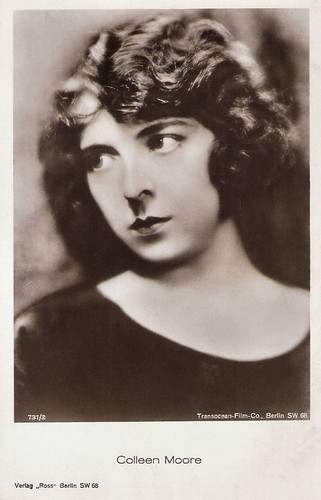
German postcard by Ross Verlag, no. 731/2, 1925-1926. Photo: Transocean-Film-Co., Berlin.
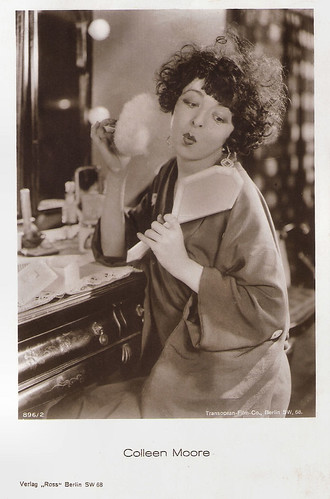
German postcard by Ross Verlag, no. 896/2, 1925-1926. Photo: First National Pictures, New York.
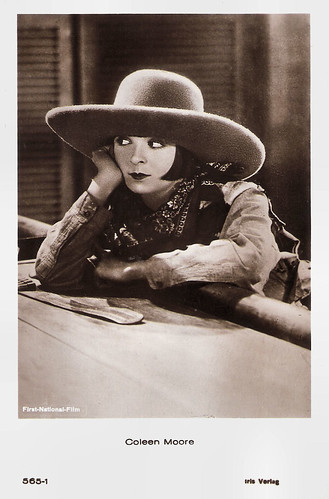
Austrian postcard by Iris-Verlag, no. 565-1. Photo: First-National-Film. Publicity still for The Desert Flower (Irving Cummings, 1925).
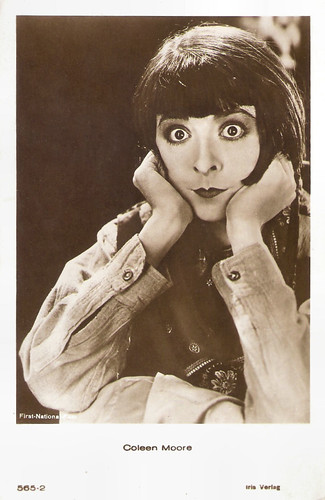
Austrian postcard by Iris-Verlag, no. 565-2. Photo: First-National-Film. Publicity still for The Desert Flower (Irving Cummings, 1925).
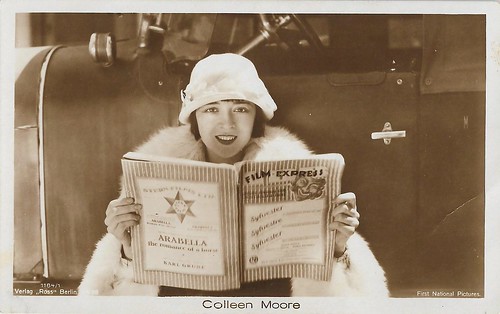
German postcard by Ross Verlag, no. 1184/1, 1927-1928. Photo: First National Pictures.
The inventor of the 'flapper' look
The film which defined Colleen Moore as the inventor of the 'flapper' look was Flaming Youth (John Francis Dillon, 1923), in which she played Patricia Fentriss. Her Dutch bob in the film was soon copied by hairdressers across America and her air of an emancipated young woman inspired countless imitations.
In 1923, she married the first of her four husbands, Frank McCormick, production head of First National Pictures, later part of Warner Brothers. There followed such films as The Perfect Flapper (John Francis Dillon, 1924), The Desert Flower (Irving Cummings, 1925), Ella Cinders (Alfred E. Green, 1926) and Her Wild Oat (Marshall Neilan, 1927).
By 1927 she was the top box-office draw in the US, making $12,500 a week. Her second husband was a New York broker, Albert F. Scott. Moore put her money into the stock market, making very shrewd investments.
She took a hiatus from acting between 1929 and 1933, just as sound film was introduced. Her four sound pictures released in 1933 and 1934 were not financial successes. Moore then retired permanently from screen acting. Her final film role was as Hester Prynne in The Scarlet Letter (Robert G. Vignola, 1934).
In 1937 she married her third husband, Homer Hargrave, again a stockbroker, and ended her film career. After she retired she wrote two books on investing and she travelled widely, frequently to China.
At 83, she married her fourth husband, builder Paul Maginot. In 1988, Colleen Moore died of an undisclosed ailment in Paso Robles, California. She was 88. At the time of her death she was writing a novel, a Hollywood murder mystery centred around a Mae West type.
Tragically, approximately half of Moore's films are now considered lost. Of her most celebrated film, Flaming Youth (1923), only one reel survives.
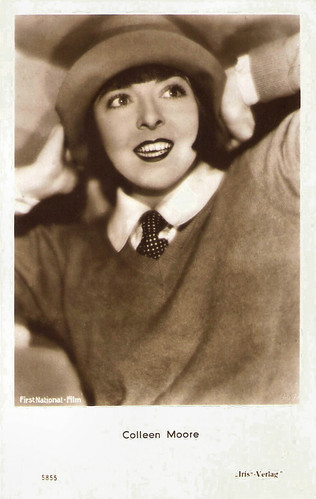
Austrian postcard by Iris-Verlag, no. 5855. Photo: First National-Film.
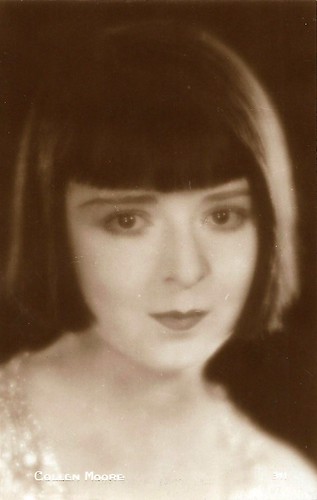
French postcard by Editions Cinémagazine, no. 311.
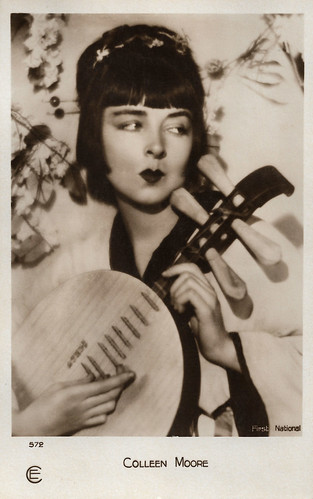
French postcard by Cinémagazine-Edition, no. 572. Photo: Roman Freulich /First National. The photo was specially posed for Motion Picture magazine in 1928.
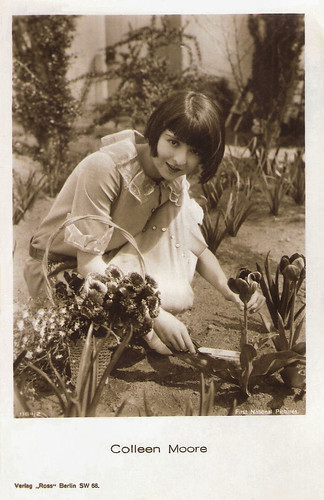
German postcard by Ross Verlag, no. 1184/21, 1927-1928. Photo: First National Pictures.
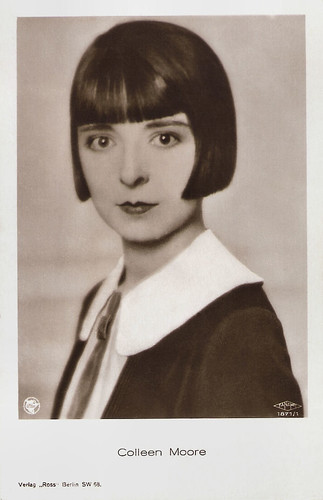
German postcard by Ross Verlag, no. 1871/1, 1927-1928. Photo: First National Pictures / Fanamet.
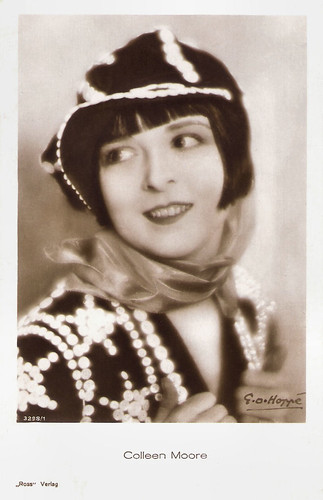
German postcard by Ross Verlag, no. 3298/1, 1928-1929. Photo: E.O. Hoppé.
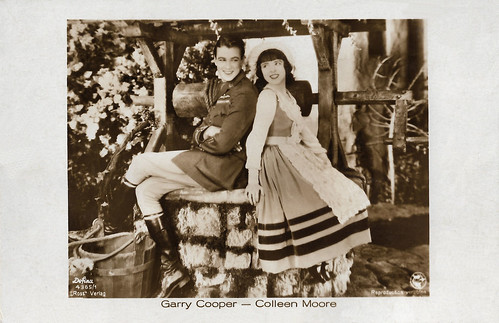
German postcard by Ross Verlag, no. 4365/1, 1929-1930. Photo: Defina / First National. Publicity still for Lilac Time (George Fitzmaurice, 1928) with Gary Cooper.
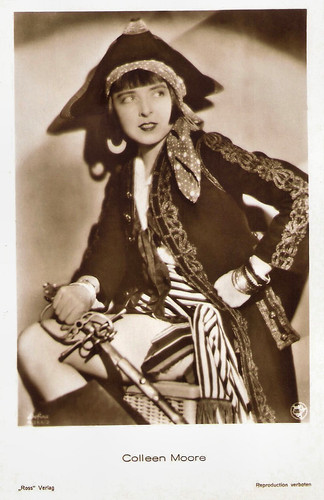
German postcard by Ross Verlag, no. 4366/2, 1929-1930. Photo: Defina / First-National-Film. Publicity still for Oh Kay! (Mervyn LeRoy, 1928).
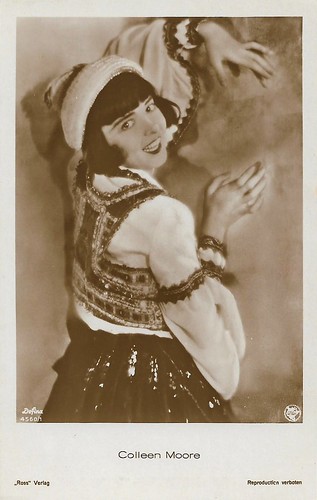
German postcard by Ross Verlag, no. 4560/1, 1929-1930. Photo: Defina / First National.
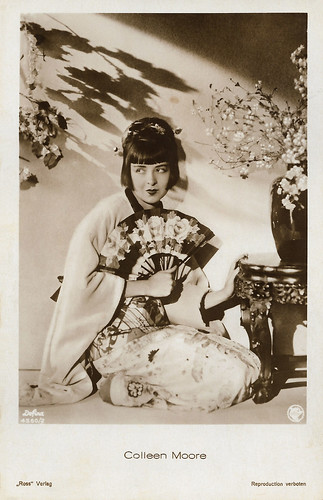
German postcard by Ross Verlag, no. 4560/2, 1929-1930. Photo: Defina / First National Pictures.
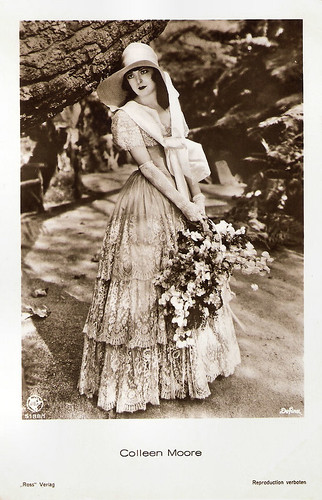
German postcard by Ross Verlag, no. 5188/1, 1930-1931. Photo: First National / Defina.
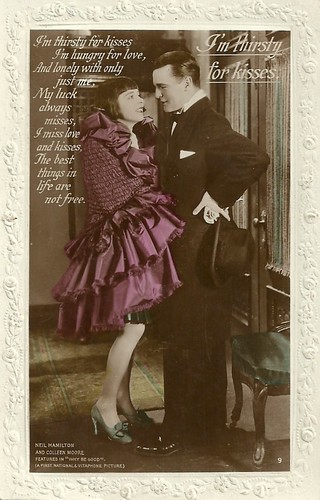
British postcard, no. 9. Photo: First National Pictures. Colleen Moore and Neil Hamilton in Why Be Good? (William A. Seiter, 1929).
Sources: Glenn Fowler (The New York Times), Denny Jackson (IMDb), Ed Stephan (IMDb), Wikipedia and IMDb.